For some unknown reason, my SBS 2008 port mappings are incorrect!
My SBS 2008 server uses the (static) IP address 192.168.0.10, but important ports (80, 443, 4125) are pointing to 192.168.0.20. My router (NETGEAR WPN824v2) is managed by SBS 2008 and there doesn't seem to be a way to change them via the browser windows (launched from the SBS console, some ports show, but not the one mentioned above), nor the Windows SBS Console application.
How can I either take manual control of the router, or change the incorrect port mappings using the SBS tools?
Update (clarification really): I can access the router directly from the SBS machine (other machines will show me a message saying that the router is managed by 192.168.0.10), but the 3 ports are not listed in the list of forwarded ports. Trying to set them using the browser interface will result in an error message stating that the port is already being forwarded!
Maybe there is a way to set the router to no longer be managed by 192.168.0.10?
Solution: Turn the UPnP functionality off on the Netgear router and voila, I can now control the port mapping on the router again for the 3 ports.

